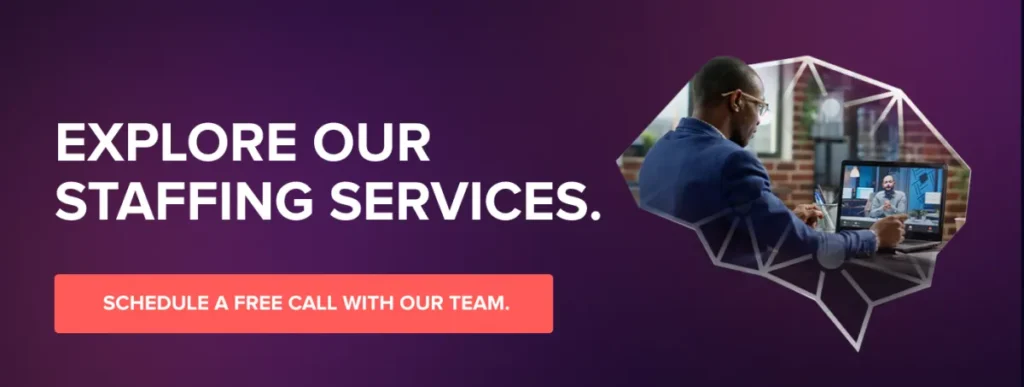Introduction

Have you ever wondered what makes a Scrum Master indispensable in today’s agile-driven business landscape? This pivotal role goes beyond managing tasks and deadlines; it’s about empowering teams, fostering innovation, and navigating through complex project terrains with agility and vision. As we delve into the nuances of the Scrum Master job description, this guide aims to unravel the threads that connect aspiring Scrum Masters and the companies eager to harness their skills.
Employers seeking the ultimate foundation for crafting a Scrum Master job description need look no further. By following the link below, you can download a complimentary job description template that not only outlines the essential responsibilities and qualifications for a Scrum Master but also incorporates the best practices of C9Staff’s renowned hiring methodology. This template is designed to streamline your recruitment process, ensuring you attract top-tier candidates by clearly communicating the dynamic role and expectations of a Scrum Master in your organization. Enhance your hiring strategy today by accessing this indispensable resource directly through the provided link.
Scrum Master Job Description Template

In the upcoming sections, we will explore from two distinct yet interconnected perspectives: the aspirants who aim to step into the dynamic shoes of a Scrum Master and the employers who are on the lookout for such transformative figures. For candidates, we will detail the essential skills, competencies, and pathways that pave the road to becoming a Scrum Master, including insights into certification and career progression. For employers, we’ll provide a blueprint on crafting compelling job descriptions that capture the essence of what to seek in a top-tier Scrum Master, alongside strategies for integrating their talents into the organizational fabric to enhance agility and productivity.
The purpose of this guide is clear: to furnish a comprehensive resource that not only educates but also empowers both job seekers and employers. Whether you are aiming to navigate your first steps in agile project management or looking to refine your recruitment approach to attract agile leaders, this guide promises to equip you with the knowledge and insights needed to succeed. Join us as we uncover the layers of responsibilities, skills, and opportunities that define the Scrum Master’s role, ensuring you are well-prepared to either claim this title or appoint the ideal candidate who can make a significant impact on your organization’s future.
Understanding the Role of a Scrum Master

The Scrum Master is not just a role within a team; it’s a vital element that drives the agile framework forward in project management. Imagine the Scrum Master as a linchpin, a pivotal point around which all project activities revolve. From facilitating daily scrums to resolving impediments that may hinder team progress, the Scrum Master ensures that the team adheres to agile practices consistently and effectively. They act as a bridge between the theoretical frameworks of agile methodologies and the practical challenges of executing projects, making sure that the team remains focused and efficient throughout the project lifecycle.
Importance in Agile Teams In the landscape of agile project management, the Scrum Master’s role transcends that of a mere facilitator. They are the leaders who champion agile principles, guiding their teams through the complexities of each project with agility and foresight. It’s their leadership that molds a group of individuals into a cohesive unit focused on common goals. Key attributes such as strong communication skills, empathy, and a deep understanding of agile methodologies are essential for a Scrum Master. These skills are critical in maintaining high team morale and navigating the team through the highs and lows of a project.
Real-World Impact: A Case Study Consider the story of a technology startup struggling with delayed releases and low team morale. A newly appointed Scrum Master began by implementing structured daily scrums and iterative review sessions to address ongoing issues more promptly. Through their efforts, the team not only met their next product release cycle but also improved their working relationships, resulting in a more collaborative and enthusiastic team environment. This scenario highlights how a Scrum Master’s adept handling of agile practices and team dynamics can lead to significant improvements in project outcomes and team satisfaction.
The Dynamic Role of a Scrum Master As you read through this section, reflect on the transformative role a Scrum Master plays in translating agile principles into successful, tangible outcomes. Whether you are an aspiring Scrum Master eager to make your mark or an employer looking to fortify your team’s agility, understanding these aspects of the role can greatly influence your approach and success in agile environments. Let this guide inspire you to appreciate or embody the qualities that make a Scrum Master so crucial in today’s fast-paced project landscapes.
2024 Complete Guide: Your Path to Becoming a Scrum Master | Career Roadmap & Insights | Simplilearn
For Candidates – What You Need to Know

Standing on the brink of a career as a Scrum Master, you must first understand the diverse array of skills required to thrive. At the core, a Scrum Master needs a robust set of technical skills including a deep understanding of Agile practices and methodologies. Equally, if not more important, are the soft skills such as leadership, communication, and conflict resolution. These skills allow a Scrum Master to facilitate discussions, encourage teamwork, resolve obstacles, and ensure that the team remains focused and motivated throughout the project. Your ability to act as both a servant leader and a coach will be pivotal in steering your team towards achieving their sprint goals.
Certifications and Educational Paths
Elevating your qualifications with certifications is a significant next step. Certifications such as the Certified ScrumMaster (CSM) from the Scrum Alliance or the Professional Scrum Master (PSM) from Scrum.org are highly regarded. These programs not only teach the fundamentals of Scrum but also test your ability to apply these principles in practical scenarios. They can greatly enhance your visibility in the job market and affirm your commitment to the agile principles and practices. Completing these courses will provide you with the necessary credentials to stand out and demonstrate your capability and dedication to potential employers.
Career Progression and Opportunities
The journey of a Scrum Master is full of potential for growth and development. Initially, you might start in an entry-level role where you’ll learn the ropes of day-to-day Scrum processes. As you gain experience, you can move into more senior roles, potentially overseeing multiple Scrum teams or evolving into an Agile Coach. Each step forward will offer opportunities to mentor others, develop strategic initiatives, and even influence organizational change. Understanding these pathways and what they entail will help you plan your career and set realistic, achievable goals.
Insights from Industry Experts
To provide a clearer perspective, let’s incorporate wisdom from seasoned Scrum Masters. One common piece of advice is to remain ever-curious and continuously seek knowledge about both Agile and general management techniques. As one expert puts it, “The learning never stops in Agile; with each project comes a new challenge and a new opportunity to grow.” Such insights are invaluable for keeping you motivated and focused on your long-term career objectives.
Are you ready to supercharge your career and land your dream job? C9Staff invites you to submit your resume through the link below and connect with our talent acquisition team. If your qualifications align with our client requirements, we will reach out to explore potential opportunities tailored to your expertise and career aspirations. Don’t miss this chance to make a significant leap forward in your professional journey.

Mastering the Interview: Expert Techniques for Hiring the Right Scrum Master
For Employers – Crafting the Perfect Job Description
As an employer, your first step in attracting top-tier Scrum Master candidates is to craft a job description that not only describes the role but also sells it. A well-designed job description starts with a clear title and a summary that highlights the role’s importance within your organization. Detail the necessary skills, experiences, and educational qualifications required for a successful Scrum Master. Emphasize technical skills such as proficiency in Agile software and tools, along with soft skills like leadership, communication, and problem-solving abilities. Ensure that each requirement is clearly linked to daily responsibilities, helping candidates see how their skills will be utilized and valued.
Competitive Salary and Benefits
To attract the best candidates, it’s crucial to offer a competitive salary and benefits package. Research the current market trends to understand the salary range for Scrum Masters in your region and industry. Remember, compensation is more than just salary; it includes benefits like health insurance, retirement plans, professional development allowances, and perhaps flexible working conditions. Highlighting these aspects shows potential candidates that your organization values its employees and is committed to their growth and well-being.
Cultural Fit and Role Expectations
A compelling job description must also articulate the cultural fit and specific expectations of the Scrum Master within your company. Describe your company culture—whether it’s collaborative, innovative, or customer-focused—and how the Scrum Master will contribute to this environment. Be specific about the role expectations, such as facilitating scrum ceremonies, coaching team members, and driving Agile projects to successful delivery. This clarity helps candidates assess if they align with your organizational values and goals, ensuring a mutual fit.
Employers seeking the ultimate foundation for crafting a Scrum Master job description need look no further. By following the link below, you can download a complimentary job description template that not only outlines the essential responsibilities and qualifications for a Scrum Master but also incorporates the best practices of C9Staff’s renowned hiring methodology. This template is designed to streamline your recruitment process, ensuring you attract top-tier candidates by clearly communicating the dynamic role and expectations of a Scrum Master in your organization. Enhance your hiring strategy today by accessing this indispensable resource directly through the provided link.
Scrum Master Job Description Template

Common Mistakes and Best Practices

For Candidates: Common Errors in Applications and Interviews
As you step into the shoes of a Scrum Master candidate, it is crucial to be aware of the common pitfalls that many fall into during the application and interview process. A frequent oversight is the underestimation of soft skills such as communication, teamwork, and adaptability. These skills are often as important as technical knowledge in agile environments where collaboration is key. Additionally, candidates often fail to provide concrete examples of their achievements in past roles, which can hinder an employer’s ability to gauge their suitability for the position. Another common error is a lack of clear understanding or expression of agile methodologies, despite these being central to the role of a Scrum Master. To stand out, ensure that you can articulate how you have applied agile principles effectively in previous projects.
For Employers: Drafting Job Descriptions
On the employer side, drafting an effective job description is your first step towards attracting the right candidates. Common mistakes include being too vague about the responsibilities and requirements of the role, which can attract a high volume of unsuitable applicants. Failing to articulate the organizational culture and the specific expectations for the role can also deter potential candidates who are a good fit from applying, as they cannot see themselves within your team or align their goals with those of your organization. To avoid these issues, ensure your job descriptions are clear, detailed, and reflective of the actual day-to-day duties and cultural environment of your company.
Best Practices for Candidates and Employers
To optimize the recruitment process, candidates should prepare thoroughly for interviews. This includes researching the company’s culture, being ready to discuss how your specific skills can meet the company’s needs, and demonstrating a proactive approach to continuous learning in agile practices. Highlight your readiness to integrate into the company’s culture and your enthusiasm for contributing to its agile journey.
Employers should strive to communicate clearly the expectations and growth opportunities available within the role. This not only attracts candidates who are ambitious and looking for career growth but also ensures that the role is a good fit for their career aspirations. A structured interview process that assesses both technical abilities and cultural fit is also crucial. This approach ensures that the candidates are not only capable of performing their duties but are also a good match for your team’s dynamics.
Trends in Agile Project Management

In the dynamic realm of agile project management, staying abreast of the latest trends is not just beneficial—it’s imperative. Recent advancements such as the integration of AI and machine learning for project forecasting are revolutionizing how projects are managed and executed. These technologies are not only enhancing the accuracy of project timelines but also improving resource allocation and risk assessment. Additionally, the rise of remote and distributed teams is becoming a staple, driven by global connectivity and recent shifts towards remote work. This trend demands new strategies for collaboration and project tracking across different time zones and geographies.
Moreover, there is an increased focus on scalability and adaptability in agile frameworks. Organizations are now recognizing the need to be agile not just in IT but across their entire operation, from HR to marketing, which requires Scrum Masters to operate at increased levels of flexibility and strategic insight.
Impacts on Scrum Masters’ Roles and Skills
These trends significantly impact the role and responsibilities of Scrum Masters. The shift towards virtual teams necessitates that Scrum Masters become adept in managing and motivating teams remotely. This includes mastering digital collaboration tools and developing techniques to maintain team cohesion without the benefit of physical presence. Furthermore, as projects become more complex and integrated across different departments, Scrum Masters are required to enhance their strategic thinking abilities. They need to not only oversee individual agile projects but also understand and influence the broader business outcomes and strategic goals.
The Future of Scrum Master Roles
Looking ahead, the role of the Scrum Master is poised for further evolution. As agile methodologies continue to permeate various sectors beyond IT, such as construction, healthcare, and education, the demand for Scrum Masters who can adapt agile practices to diverse industries will escalate. Additionally, the advent of global project management standards and the continuous updating of agile certifications will require Scrum Masters to engage in lifelong learning and regular skill upgrades.
Emerging technologies like AI and blockchain might also lead to new responsibilities for Scrum Masters, including the oversight of automated processes and ensuring ethical use of data in project management. As organizations strive for higher agility, the Scrum Master’s role will expand from a facilitator of agile practices to
Employers committed to enhancing their team with the ideal Scrum Master are invited to discover how C9Staff can optimize your recruitment process. By clicking the link below, you can schedule a free exploratory call with one of our account managers today. During this call, we will attentively listen to your specific needs, recommend potential candidates, and help you assess the best talent at competitive prices—all for free. Take the first step towards securing top-tier talent perfectly suited to your organization’s unique requirements.

Conclusion
As we conclude this exploration into the role of Scrum Masters, it’s clear that their position within agile project management is both complex and critical. We’ve journeyed through the fundamental responsibilities that define the Scrum Master, from facilitating daily scrums to removing obstacles that hinder team progress. The skills and certifications necessary for excellence in this role have been detailed, emphasizing the need for continuous learning and adaptation to maintain relevance in this rapidly evolving field.
Employers have gained insights into crafting precise and appealing job descriptions, which are crucial for attracting the right talent. We’ve also uncovered common pitfalls that both candidates and employers often encounter, providing strategies to avoid these and enhance the recruitment process. Furthermore, the discussion on future trends, including the integration of new technologies and methodologies into agile practices, sets the stage for what lies ahead in this career path.
Scrum Masters are far more than just facilitators; they are pivotal leaders essential for driving project success and fostering innovation within their teams. As businesses continue to adopt and integrate agile methodologies across various sectors, the Scrum Master’s role becomes increasingly vital. They ensure that agile teams thrive in a landscape marked by continual change and technological advancement.
Now, armed with a comprehensive understanding of the Scrum Master’s role, responsibilities, and the emerging trends shaping their world, it’s time for action. For those aspiring to become Scrum Masters, let this guide serve as a roadmap for acquiring the necessary skills and qualifications. Dive into certification courses like CSM or PSM, and actively seek out opportunities to hone your practical skills in real-world settings.
For employers, this article serves as a reminder of the importance of meticulous job description crafting and the benefits of a proactive approach to recruitment. Attracting and retaining top-tier Scrum Master talent requires clarity in communication and an understanding of the evolving nature of agile roles.
Both job seekers and employers should continue to engage with the evolving practices of agile project management. Stay abreast of new developments and incorporate these insights into your strategies for career development or talent acquisition. By doing so, you’ll ensure that you not only keep pace with the industry but also set the standards for success and innovation in your respective fields.
Let this guide inspire you to take the steps needed to excel in the dynamic and challenging world of agile project management. Whether you are stepping into the shoes of a Scrum Master or seeking to hire one, the journey towards excellence is continuous and ever-evolving. Embrace it with enthusiasm and a commitment to excellence.



